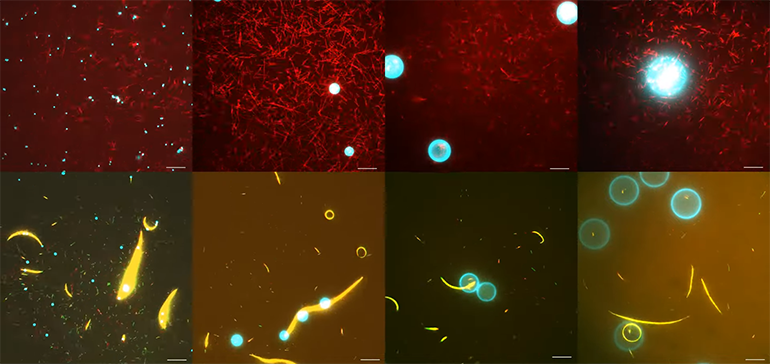Researchers at Hokkaido University in Japan created molecular robots that can employ swarm behaviors to move and release small cargoes. The robots can be controlled using light, and they consist of biological components, including DNA, microtubules, which are a cytoskeletal component, and kinesin, which is a motor protein that interacts with microtubule filaments. The technology could have significant potential as a drug delivery mechanism, and may lead to a variety of future nanotechnological medical applications. While the technology is currently in its infancy, if the researchers can make the technique work inside the body, then microrobot swarms could conceivably accomplish a variety of tasks minimally invasively, from tackling tumors to delivering drugs.
A single bee isn’t particularly powerful, but a swarm of them can make the toughest of us start running. This is the philosophy behind this newest technology, which harnesses the power of microrobot swarms and is bioinspired by the behaviors of cooperative animals. Robot swarms are currently under investigation for a variety of tasks, including moving items or forming complex structures. A swarm can respond to evolving situations and perform complex tasks that are far beyond the capabilities of a single robot.
However, achieving these types of swarm behaviors on a micro level is a whole lot more challenging. These researchers have made an impressive first step using microrobots they have created with biological components. These include DNA that is linked to microtubules, a component of cytoskeleton that gives cells their shape and structure. Cleverly, the researchers also incorporated kinesin, a motor protein that can act on and move microtubules, and in this context the protein provides a means of propulsion.

Schematic illustrations of cargo transport by a swarm of molecular robots (top) and fluorescence images of a molecular robot transporting blue sphere-like cargo (bottom). The scale bar is 20 micrometers. By specifying the position of the light irradiation, it is possible to accumulate the cargo at the designated destination (right). The scale bar is 50 micrometers (Mousumi Akter, et al. Science Robotics. April 20, 2022).
They also included azobenzene, a light-sensitive compound, as a means to control the swarming behavior. Illuminating the microrobots with visible light causes the azobenzene to change structure, resulting in the DNA forming double strands, which induces swarming. Conversely, this process can be halted by exposing the microrobots to ultraviolet light.
So far, the researchers have tested the microrobots in their ability to move a cargo, in this case small polystyrene beads, and they were able to induce the robots to transport the cargo in response to light. Swarms were capable of moving larger beads than individual robots.
“In the near future, we expect to see microrobot swarms used in drug delivery, contaminant collection, molecular power generation devices, and micro-detection devices,” said Akira Kakugo, a researcher involved in the study.
See a video of the robots moving beads:
In the following video the microrobots unload their cargo in response to UV light:
Studies in Science Robotics: Cooperative cargo transportation by a swarm of molecular machines
Via: Hokkaido University
